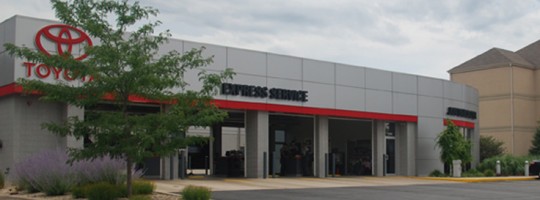Breaking Down Quick Service for Car Dealers: Introduction to the Business Model, Part 3

Speed + Process = Maximum ROI in Express Service. Automotive Dealership Coach and former GM Joe St. Marie shares simple practices to win customer loyalty and make a buck.
In the first of the Breaking Down Quick Service for Car Dealers, Part 1, we introduced Joe St. Marie, dealership coach and former general manager of Jon Lancaster Toyota. St. Marie is recognized in the industry as a leader that isn’t afraid to get in the trenches and get his hands dirty. By establishing a clear vision across team members and incorporating daily one-on-one and group coaching, St. Marie has a track record of unprecedented performance.
Consistency and accountability are common themes when St. Marie talks about working in dealerships. Whether it is a blessing or a curse, his level of ambition exudes never-ending advancement in practices, both technical and interpersonal. The following list exemplifies the high-level accountabilities he owned and practiced in quick service as GM of Jon Lancaster Toyota.
1. Communicating the Business Model to Align Employee Effort
Wes Rydell shaped St. Marie’s early understanding of quick service. “Way back I asked Wes Rydell how much he made on an oil change,†St. Marie shared. “His response was ‘I don’t know.’†The Rydell group is well known as the “little profit dealer,†focused on volume and customer loyalty instead of margins. In St. Marie’s formative years, this interaction underscored how little the profit on oil change meant in the grand scheme of the model.
The metrics that serve express service are completely counterintuitive to the traditional service manager, so St. Marie made it his responsibility to foster that understanding throughout the team. Metrics that better serve the model don’t stand alone, but include a specific formula of dollars per repair order, throughput, as well as material and labor costs.
2. Focus on Guest Service
In the early 2000s, Lancaster attended an OEM event that spurred the express service construction. He was convinced that continued sales growth depended upon customer retention through fixed operations. But, the current state of fixed ops would not cut it with the convenience-driven consumer.
Lancaster built the facilities as a customer retention mechanism. St. Marie’s execution of that vision was simple, yet firm: take care of the guest. A number of ancillary factors supported it: facility design, premium beverages, free car wash, and a value proposition of 15-minutes for oil, filter, 21-point inspection, and tire rotation.
However, the lifeblood of customer loyalty was in the guest service in each employee-customer interaction.
One example: The 21-point inspection was completed as early in the transaction as possible. By offering additional (and ONLY relevant) add-ons early in the guest’s wait time, they were more likely to accept additional service. If they didn’t have time and wanted to schedule the maintenance, the response was “what time fits in your schedule?†St. Marie said they always made it work.
Team members were instructed and accountable for the dealership’s standard practices in guest interactions. Good/better/best offerings allowed the vehicle owner to decide price and quality with options. Consistent reporting aligned with factory recommended maintenance helped advisors build trust for future sales. St. Marie coached the team through the process.
3. Recruiting for the Model
St. Marie says recruiting a capable team was easy. He called local tech school instructors to open the door. Once the store built a reputation, word-of-mouth was huge among students.
“Because we had irregular shift hours, it was easy to plug in students. They were happy to be working along with their educational commitments,†Lancaster said. A major piece of the organization’s design was to expose “newbies†to their potential career path.
“The quick lube was programmed as a training ground,†Lancaster continued. “We looked at technical ability; but also work ethic and attitude – and gauged potential from there.â€
4. Setting Up Employees for Success
Lancaster is well known in the industry for being very risk tolerant to investments in process improvement.
The Jon Lancaster Toyota express service bays were set up to be first-class facilities for both guests and team members. Each station had an identical, full set of tools. Looking for a tool or walking across the shop for a tool was viewed as a waste of time in the speed and volume driven environment.
Beyond equipment, training was of high value throughout the department. Lancaster spoke of St. Marie with high regard. “Joe was not above taking an hour to discuss 21-point standards with a new employee,†he said. “A lot of GMs might have the attitude that taking that kind of time was a waste, but that’s just not how he looked at it.â€
5. Staffing for Volume and Accuracy
For St. Marie, matching team members with traffic flow was a science gained through market experience and “reviewing game film.†He strived to reach less than one hour of labor for every vehicle going through. (Average ticket: $90).
On a given shift, St. Marie staffed a team leader, three advisors, and nine to 12 entry-level technicians. In a stall, one lower bay (pit) technician could handle multiple lanes while two upper bay techs worked under the hood filling fluids, performing the inspection, and tire rotation. Three technicians per vehicle worked ideally to minimize mistakes and lost productivity.
Balancing metrics within quick service lies in understanding its intricacies. Behind the scenes, St. Marie was personally accountable to daily, weekly, and monthly performance data. “If you accurately measure results, you are in a better position to make improvements,†he said.
With a solid grasp on the business model and a plan for executing it daily, dealerships stand to make their lives a lot easier. Who can argue with happy customers today that want to do business with you tomorrow?












Warning: count(): Parameter must be an array or an object that implements Countable in /home/pg4b1yzvrqqo/domains/test.drivingsalesnews.com/html/wp-includes/class-wp-comment-query.php on line 399